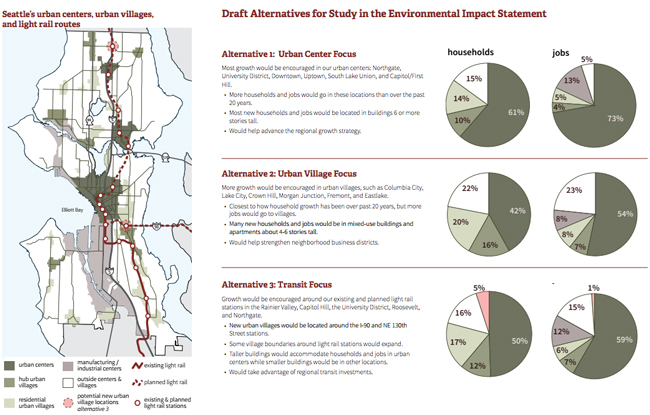Editor’s Note: In case you missed our previous coverage of Seattle 2035, check out DPD’s Background Report, which covers the city’s planning data from 1995-2012.

The Department of Planning and Development (DPD) has been working hard over the past few months to plan for Seattle’s future growth. To do that, DPD must update the city’s Comprehensive Plan. The project has now moved into its environmental review phase, which means preparing an Environmental Impact Statement (EIS).
On Monday, DPD (and consultant Studio 3MW) will hold an open house and presentation to talk about the EIS Scoping process and unveil three alternatives to the future Comprehensive Plan. The EIS will evaluate each alternative for its impacts and benefits of accommodating growth over the next 20 years. Some of the topics that the EIS will analyse include transportation, public services, housing affordability, health, social justice, and environmental resources.
Seattle has very specific growth targets for the next 20 years. The Growth Management Planning Council of King County has charged Seattle with the responsibility of accommodating up to 70,000 new households and 115,000 new jobs by 2035. Each alternative accommodates these levels of growth, but distributes them differently within the city. In brief, these are the general differences between the Comprehensive Plan growth alternatives:
- Alternative 1: Urban Centers Focus – This alternative would primarily focus development in the city’s existing urban centres. It would achieve this by accommodating the vast majority of new housing and jobs through mid-rise and high-rise development within those centres.
- Alternative 2: Urban Village Focus – This alternative essentially mimics the current land use development pattern of the city, but focuses more jobs in urban villages.
- Alternative 3: Transit Focus – This alternative would establish two new urban villages to support high capacity transit investments already in the pipeline. Other urban villages could expand in size if in proximity to light rail stations.
The event begins at 5pm on March 24, 2014 in the Bertha Knight Landes Room at Seattle City Hall. The agenda is as follows:
- 5pm-5.30pm: Open House with staffed displays about the Comprehensive Plan, Seattle 2035, Growth Alternatives, Environmental Impact Statement process
- 5.30pm-5.45pm: Presentation about Comprehensive Plan and Seattle 2035 by DPD
- 5.45pm-6pm: Presentation about the Environmental Impact Statement process by Studio 3MW
- 6pm-6.30pm: Public Comments on proposed Growth Alternatives
- 6.30pm-7pm: Open House continues with staffed displays about the Comprehensive Plan, Seattle 2035, Growth Alternatives, and Environmental Impact Statement process
You are encouraged to attend the event on Monday where staff will answer your questions and take comments on the growth alternatives. The scoping period for public comment runs through April 21, 2014. Comments can also be made through e-mail: 2035@seattle.gov.
Stephen is a professional urban planner in Puget Sound with a passion for sustainable, livable, and diverse cities. He is especially interested in how policies, regulations, and programs can promote positive outcomes for communities. With stints in great cities like Bellingham and Cork, Stephen currently lives in Seattle. He primarily covers land use and transportation issues and has been with The Urbanist since 2014.


